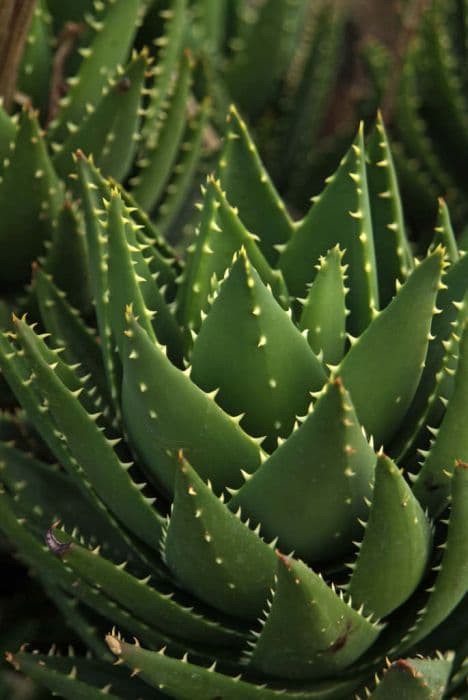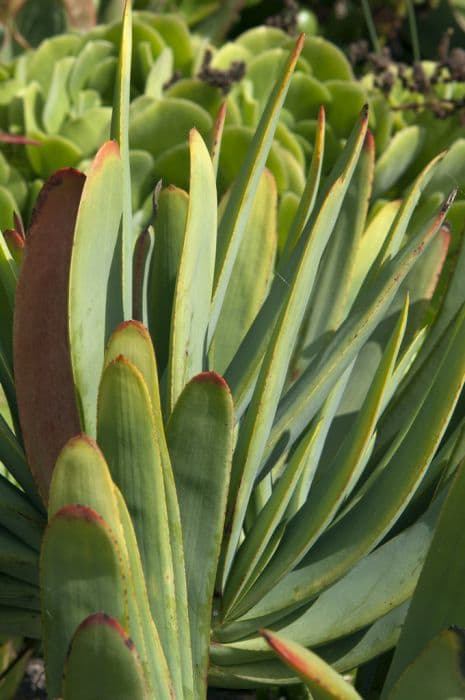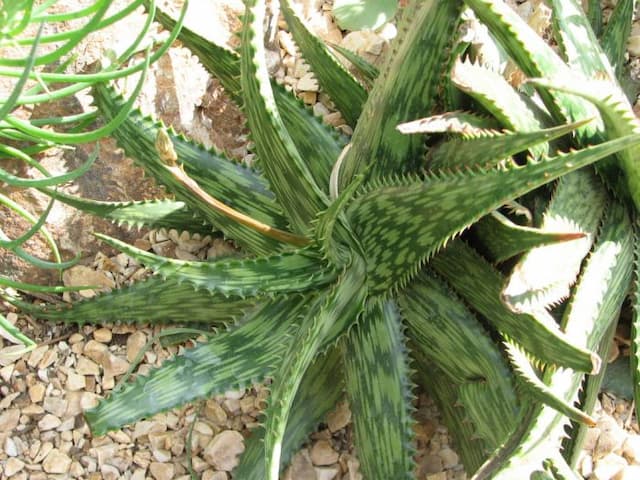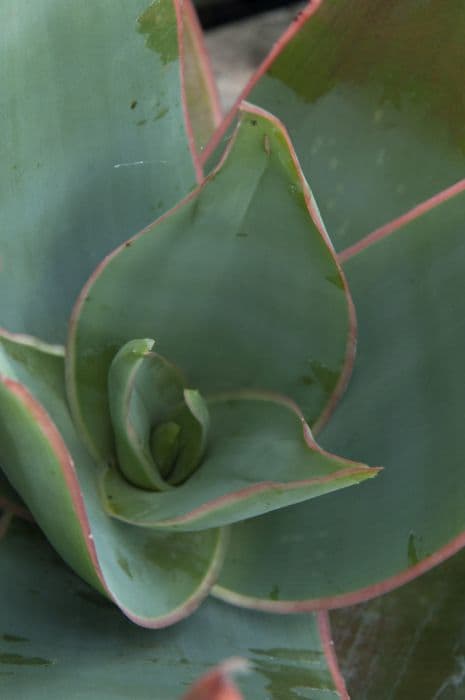Little Warty Gasteria Gasteria 'Little Warty'
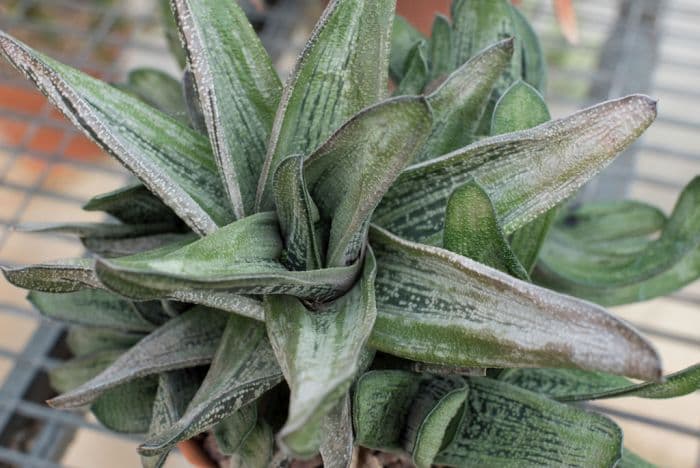
ABOUT
Gasteria 'Little Warty' is a distinctive succulent plant characterized by its thick, fleshy leaves which have a rough, warty texture, hence its name. The leaves are arranged in a rosette pattern, sprawling outwards from the center of the plant. 'Little Warty' displays a unique color palette, with a base color of deep green that can often appear almost mottled due to the presence of white spots or markings. These spots are not uniform, giving each leaf a one-of-a-kind pattern. The leaf surface may appear glossy or slightly translucent, which is particularly noticeable in bright light. The edges of the leaves are typically smooth, lacking any sharp spines or serrations which makes it safe and pleasant to handle. The succulent's sturdy leaves taper to a point and have a curved appearance, often resembling the shape of a tongue. 'Little Warty' makes an interesting addition to indoor plant collections, rock gardens, or as a desk plant due to its ornamental and quirky look, making it a popular choice for those seeking an unusual yet low-maintenance plant.
About this plant
 Names
NamesFamily
Asphodelaceae
Synonyms
Little Warty
Common names
Gasteria 'Little Warty'
 Toxicity
ToxicityTo humans
Gasteria 'Little Warty', commonly known as Little Warty, is not known to be toxic to humans. However, it is still advisable to avoid ingesting any part of the plant, as it may cause discomfort or an allergic reaction in sensitive individuals.
To pets
Little Warty is generally considered non-toxic to pets. Although it does not contain any known toxins harmful to pets, it is still recommended to prevent pets from chewing on the plant to avoid any possible gastrointestinal upset or allergic reaction.
 Characteristics
CharacteristicsLife cycle
Perennials
Foliage type
Evergreen
Color of leaves
Mixed
Flower color
Varies
Height
6 inches (15 cm)
Spread
6 inches (15 cm)
Plant type
Succulent
Hardiness zones
9
Native area
South Africa
Benefits
 General Benefits
General Benefits- Low maintenance - Gasteria 'Little Warty' requires minimal care, making it ideal for busy individuals or those new to gardening.
- Drought-tolerant - It's well-suited to arid environments due to its ability to store water, thus requiring infrequent watering.
- Compact size - Its small stature makes it perfect for indoor spaces such as offices or apartments.
- Unique appearance - The plant's distinctive warty leaf texture adds a decorative and unusual element to plant collections.
- Non-toxic to pets - Safe for households with pets as it is not known to be toxic to animals when ingested.
- Long-lived - With proper care, Gasteria 'Little Warty' can thrive for many years, providing a long-lasting addition to indoor or outdoor gardens.
- Easy propagation - It can be easily propagated from leaf cuttings or offsets, making it simple to increase your collection or share with friends.
 Medical Properties
Medical PropertiesThis plant is not used for medical purposes.
 Air-purifying Qualities
Air-purifying QualitiesThis plant is not specifically known for air purifying qualities.
 Other Uses
Other Uses- Gasteria 'Little Warty' can be used in miniature gardens to create a faux-alien landscape due to its unique, bumpy leaf texture.
- It can serve as an educational tool for botany students to learn about succulent plant adaptations and hybridization.
- The distinct appearance of 'Little Warty' makes it ideal for themed terrariums, such as a fantasy or prehistoric setting.
- When used in office spaces, 'Little Warty' can add a point of interest and spark conversations about its unusual name and look.
- It can act as a living ornament during Halloween festivities because of its 'warty' surface and eerie, odd appearance.
- In art installations or still life compositions, 'Little Warty' can be used to add an organic, textured contrast to man-made objects.
- The plant's structure can serve as a natural model for sculptors or artists who require organic shapes to inspire their work.
- 'Little Warty' can be used in stop-motion animation films as a stand-in for fantastical vegetation due to its unique form.
- In photography, 'Little Warty' can be a subject for macro photographs, showcasing its detailed and distinctive surface.
- Using 'Little Warty' in sensory gardens can help stimulate touch, given the unusual texture of its leaves.
Interesting Facts
 Feng Shui
Feng ShuiThe Gasteria is not used in Feng Shui practice.
 Zodiac Sign Compitability
Zodiac Sign CompitabilityThe Gasteria is not used in astrology practice.
 Plant Symbolism
Plant Symbolism- Resilience: Gasteria 'Little Warty' is a succulent that can tolerate periods of neglect and still thrive, symbolizing the ability to endure and recover from tough conditions.
- Unique Beauty: With its distinctive warty leaf texture, this plant represents the beauty in uniqueness and the importance of embracing individuality.
- Protection: Succulents like Gasteria are often associated with protection due to their thick, fleshy leaves that store water, symbolizing the idea of nurturing and safeguarding oneself or others.
- Longevity: The slow-growing nature of Gasteria 'Little Warty' signifies long life and timeless existence. It's a symbol of lasting presence and endurance over time.
 Water
WaterGasteria 'Little Warty' should be watered sparingly, as it is a succulent that stores water in its leaves. Water the soil directly, using enough water to moisten it without leaving the plant standing in water. A general rule is to water once every two weeks, but this may vary depending on the climate and the time of year. During the growing season in spring and summer, you may need to water slightly more often, while in the dormant winter months, you can reduce watering to once a month or less. It's essential to check the soil moisture before watering; if it's still damp, wait a few more days.
 Light
LightGasteria 'Little Warty' thrives in bright, indirect light. The best spot for this plant would be a north or east-facing window where it receives plenty of light but is protected from the intense midday sun. Direct sunlight can scorch the leaves, so if you only have a south or west-facing window, consider using a sheer curtain to diffuse the light.
 Temperature
TemperatureGasteria 'Little Warty' prefers a temperature range of 60 to 85 degrees Fahrenheit. It can survive minimum temperatures down to around 50 degrees Fahrenheit, but should not be exposed to frost, as it can severely damage the plant. The ideal growing conditions involve maintaining a consistent temperature in the preferred range, avoiding sudden drops or spikes.
 Pruning
PruningGasteria 'Little Warty' requires minimal pruning, primarily to remove dead or damaged leaves which can be gently plucked or cut off near the base. Pruning may also encourage a more compact growth habit. The best time to prune is in the spring as the plant enters its active growth phase, but occasional removal of unsightly leaves can be done at any time.
 Cleaning
CleaningAs needed
 Soil
SoilGasteria 'Little Warty' thrives best in a well-draining cactus or succulent soil mix, which typically consists of a blend of potting soil, coarse sand, and perlite or pumice. The ideal soil pH for Gasteria plants is slightly acidic to neutral, ranging from about 6.0 to 7.2. Ensure the mix is loose and gritty to facilitate good drainage and prevent root rot.
 Repotting
RepottingGasteria 'Little Warty' should be repotted approximately every two to three years or when the plant outgrows its current pot. This slow-growing succulent does not need frequent repotting. Be cautious to use a container only slightly larger than the previous one with adequate drainage holes.
 Humidity & Misting
Humidity & MistingGasteria 'Little Warty' prefers average room humidity and does not require high humidity levels. Maintain humidity levels around 40-50% for optimal growth, which is standard in most indoor environments without the need for additional humidity control.
 Suitable locations
Suitable locationsIndoor
Place in bright, indirect light and water sparingly.
Outdoor
Partial sun to light shade; protect from intense afternoon sun.
Hardiness zone
9-11 USDA
 Life cycle
Life cycleGasteria 'Little Warty' begins its life cycle as a seed that germinates in warm, moist soil conditions. As a seedling, it develops fleshy, textured leaves in a rosette pattern and starts to photosynthesize. As it matures, the Gasteria plant gradually expands, producing offsets, or "pups," around the base which can be separated and grown as new plants. Throughout its growth, 'Little Warty' requires minimal water, thriving in well-drained soil with infrequent watering. It flowers sporadically, typically in the spring to early summer, sending up a tall stalk with tubular flowers that attract pollinators. After many years, the plant may slow its growth and eventually die, but not before potentially producing many generations of offsets that continue its life cycle.
 Propogation
PropogationPropogation time
Spring-Early Summer
Gasteria 'Little Warty' is often propagated through offset division. This is the most popular method for this particular succulent. As the plant matures, it naturally produces small offsets, or "pups," near the base of the parent plant. These can be separated when they have developed their own roots and are a few inches in size. To propagate, gently remove the offset from the mother plant, preferably using a clean, sharp knife. After allowing the offset to dry and callous for a few days, the offset can then be planted in a well-draining cactus or succulent potting mix. It's best to perform this propagation process in the warmer months when the plant is actively growing.
